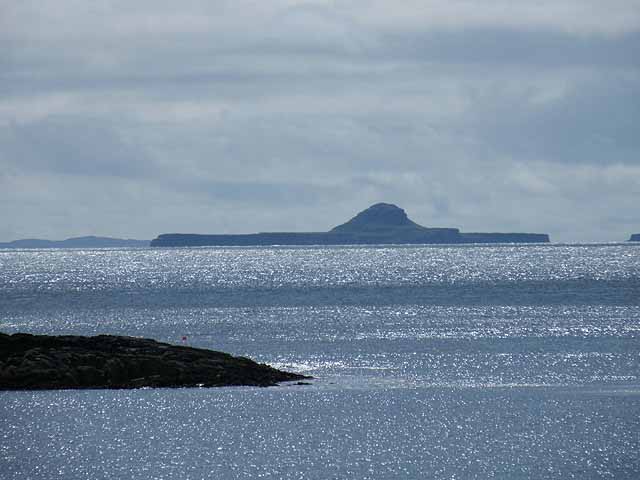This time we did it clockwise. The long stretch after Frank Lockwood's Island (near Lochbuie - which is named after Frank Lockwood, the brother-in-law of the 21st MacLean of Lochbuie - who was Solicitor General - from 1894 to 1895) was a drag = we sailed a bit and then put the motor on....
Lunga on the Treshnish Isles
The Treshnish Isles, an archipelago of several small islands, can be found off the south west coast of Mull and are best visible near Treshnish Point or Port Haunn, south of Calgary Bay. Also from Loch Tuath on Mull looking west the islands are visible on a clear day, specially due to the distinctive shape of some of the islands such as Bac Mor which is also known as the Dutchman’s Cap.
The islands have been landmarks for travellers through the Hebrides for at least 1,000 years. The names of some of the islands still reflect their importance to the Vikings who once ruled in the Hebrides. The islands, and Cairnburgh Castle in particular, had a strong strategic position well into the 1800s. The sun was shining bathing the island in a luminescent glow. There was a little path winding up the high cliffs and then there they were - puffins everywhere. It was not just Puffins. A close relative is the Guillemot was present in large numbers too.
I entered a moss-covered plateau and things got out of hand. Hugging the cliffs where thousands of Puffins, standing over their freshly dug burrows. The Puffins didn’t mind people.
We left Lunga and motored north West passing Staffa and Fingal's Cave.
Further up we were treated to a great display by the common bottlenose dolphin. They were frolicking around the boat showing off.
Tursiops truncatus or the Atlantic bottlenose dolphin, is the most well-known species from the family Delphinidae.
The waters around the Isle of Mull and the
Hebrides as a whole are home to a range of sea life, from the
diminutive Harbour Porpoise to the Minke Whale. Twenty
four different cetacean species have been seen around the Hebrides
since research started about 20 years ago, including the largest
animal on the planet, the Blue Whale. No matter when you visit
there will always be something to see as we have a number of
resident species like the Harbour Porpoise and Bottlenose
Dolphins, others such as the Minke Whale
and Common Dolphin only visit for the summer season, and some including the Fin Whale and Striped Dolphin are seen very infrequently.
and Common Dolphin only visit for the summer season, and some including the Fin Whale and Striped Dolphin are seen very infrequently.
Around the Hebrides warm Atlantic
waters mix with cooler coastal currents travelling north
from Ireland. Research has shown that the area of mixing between
these two currents produces the highest sighting rate. The
cooler waters provide more nutrients to the warmer less nutrient
rich waters, therefore the combination of the two provides the
perfect conditions for plankton to bloom and start the all
important food chain that can then support larger animals, such
as the Bottlenose Dolphins, Minke Whales and Basking Sharks.
Explore our website for top tips on where
to go to watch wildlife, further information on the range of
species and read our online blog to find out what is happening
in the sea around Mull at the moment.
We stayed on a mooring at Tobermory on Saturday 28th June. We had
Boeuf Bourguignon for dinner and bread. As we set off on Sunday at about 0930 we motored out into the Sound and saw a pod of
Bottlenose Dolphins swimming around.
We stayed on a mooring at Tobermory on Saturday 28th June. We had
Boeuf Bourguignon for dinner and bread. As we set off on Sunday at about 0930 we motored out into the Sound and saw a pod of
Bottlenose Dolphins swimming around.










No comments:
Post a Comment